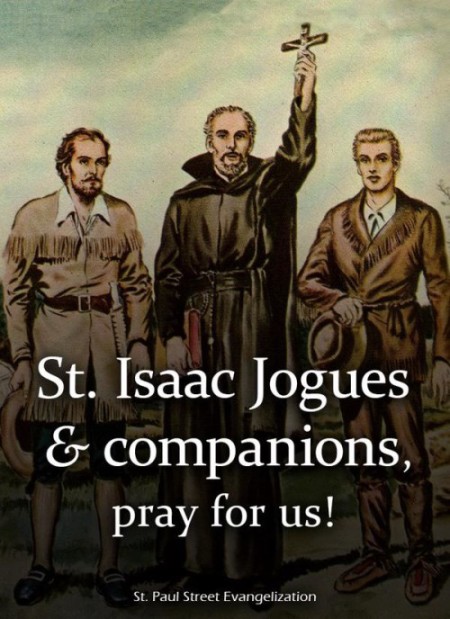 St Issac Jogues (1607-1646) and Companions (1593-1649)
St Issac Jogues (1607-1646) and Companions (1593-1649)
Image Courtesy: St. Paul Street Evangelization
(EWTN) The labors of the Jesuit and Franciscan Missionaries in the New World (North America) form an important chapter of the Church and the Western Hemisphere.
These Missionaries were for the most part men of culture and learning, carefully chosen and rigorously trained. Many of them gave up important careers in the Church to endure the dangers and hardship of the wilderness. In New France, as Canada was called then, this is where Jesuit Isaac Jogues spent his Missionaries years. Their lot was hardship, disease, solitude and not uncommon torture and/or violent death.
The perils of forest and trail, the intense cold, miserable food and pest infested huts of the Indians, changed them after a few years into haggard old men, yet their spirits remained undaunted, strengthened as they were by a resolute faith. — What the American Historian Francis Parkman in his book ‘The Jesuits in North America’ (available at Amazon.com) he wrote of Fr. John de Brebeuf, Jesuit leader in Canada, applies most equally to the other members of this noble band:
“His was the ancient faith uncurtailed, redeemed from the decay of centuries, kindled with new life and stimulated to be preternatural and fruitfulness.”
The pioneer French Explorers Cartier and Champlain, were men of devotion, eager to have the aid of the religious orders in opening up the new continent and both Jesuits and Franciscans were encouraged to establish Catholicism in Canada–Jesuits led the way there, while Franciscans and Dominicans became active in the SW United States and in South America.
Early in the 17th century, the Jesuits began to arrive in Quebec and quickly pushed on into the interior to be engulfed by the forest or to be taken prisoner by the Indians to be treated as Slaves or objects of barter, yet at times they were met with heartening response. Among the more notable of these men were: Fr. Brebeuf; Daniel; Masse; Lalemant; Chabanel; Ragueneau; Garnier; Fr. Jorgues and Le Jeune.
It was Le Jeune a Huguenot (a French Protestant) in his earlier days, that conceived the plan for keeping his Superiors of the ‘Society of Jesus’ as well as the European Laity informed of the great undertaking by the careful compilation of Missionaries letters which described in detail their experiences and impressions.
Every Summer for a period of 40 years these reports were dispatched back to Paris, where they were published serially under the title:
‘Jesuit Relations’ (1610-1791) — They form an historical chronicle of the highest value and it is to them that we are mainly indebted for our knowledge of Fr. Jogues.
Fr. Isaac Jogues joined the Jesuits at France Rouen in 1624 according to SQPN teaching literature. Fr. Jogues became a Missionary to New France (now Canada) in 1636 starting in Quebec, he worked with the Hurons and Petuns (native Americans) in the area around the Great Lakes.
This was a rough assignment for Fr. Jogues, not only were the living conditions harsh but the local Indians blamed the ‘Blackrobes’ for any disease, sickness, bad luck or any of their problems that occurred.
In August 1642, Fr. Jogues was captured by the Mohawk Indians, enslaved, tortured and mutilated for 13 months. While there, he continued to minister Christianity to any one that would listen. With the help of local Dutch Settlers, he was finally able to escape his captivity and returned to France to recover. — In 1644, Fr. Jogues would return to New France, to continue his work with the Indians and negotiated a peace-treaty with the Iroquois.
St. Jogues, St. Brebeuf and several Lay Missionaries were subsequently blamed for ‘Christian Sorcery’ by the Indians because of an epidemic of crop failures and were martyred for Christ in October in 1646 at Ossernenon, what would later become part of New York State. — In 1925 St. Jogues was Beatified and was Canonized in 1930 by Pope Pius XI
More here from Franciscan Media
Tweet